Garmin demos: GPSMAP 8600, ForwardVu, Fantom, Virb XE, Quatix3 & more
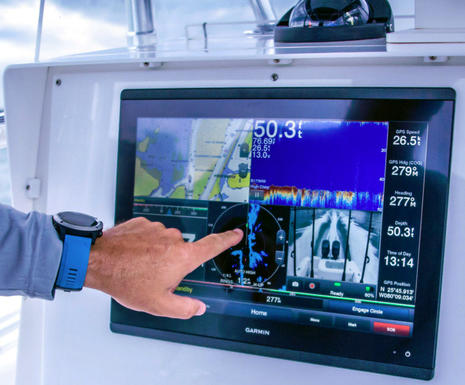 At this moment in time, the Garmin GPSMAP 8600 multifunction display announced in February may be the most powerful premium MFD available. That’s the “little” 8617 model of the series above — apparently now shipping at $7,500 retail — and that Quatix 3 smart/fitness/boat watch is not trivial technology either. So even given two full days with four Garmin-loaded boats, I feel like I only grazed the surface of all that’s going on. And frankly, the story is similar across the four major electronics brands and beyond. Next week, for instance, we hope to share some startling new features that may be coming to an MFD already on your boat. Today, though, let’s look at some Garmin demo highlights…
At this moment in time, the Garmin GPSMAP 8600 multifunction display announced in February may be the most powerful premium MFD available. That’s the “little” 8617 model of the series above — apparently now shipping at $7,500 retail — and that Quatix 3 smart/fitness/boat watch is not trivial technology either. So even given two full days with four Garmin-loaded boats, I feel like I only grazed the surface of all that’s going on. And frankly, the story is similar across the four major electronics brands and beyond. Next week, for instance, we hope to share some startling new features that may be coming to an MFD already on your boat. Today, though, let’s look at some Garmin demo highlights…
Before we get into the details, a warning is in order. The modern marine multifunction display has so many possible functions — plus Garmin is already integrating an ecology of its own portable gadgets (which the other brands may emulate via partnerships) — that a boater may throw up his or her hands in confusion and exasperation. Please don’t freak out; you generally only have to buy or use the devices, functions and features you want, and if they’re designed right, they should be fairly easy to utilize.
For instance, it only took a few Quatix 3 button pushes to get the watch into “Fish” mode — though, my bad, the start icon is about halfway through the successful sailfishing afternoon that Adam gleefully covered — and few more once we tied up. Fish mode, like many other “Activity” apps you can load into the watch, starts the GPS and brings up a couple of relevant data screens (I could record fish catches and set a tournament timer in this case). And, just like hikes and other activities I’ve recorded with the watch, the data automatically went up on my personal Garmin Connect website (above) and also to the Connect app on my phone.
It’s true that Connect does not show the fish catch and times I recorded, and there’s no way that any watch could figure out how many calories I burnt (or drank) on that mostly slow boat ride, but maybe that will be straightened out the next time I try Fish mode, because the apps and the watch update themselves automatically. And, yes, the boat’s own GPS hit nearly 60 mph on our way back through the Miami cut, so that data looks spot on. Note that Fish mode and many other Quatix 3 features work without any other Garmin devices, but during the demos I was also able to see boat data like depth and water temperature on the watch and also use the Q3 to operate Garmin Virb XE cameras that were additionally networked to Garmin MFDs.
Talk about connectivity – check out the backside of an 8600 MFD and also understand that these displays support both WiFi and ANT+ wireless protocols. Note that the four Ethernet ports make this MFD an able network switch and that the HDMI IN and USB ports mean that this display can show and control a touch command charting program running on an onboard PC (or any other PC program).
Also, HDMI IN and CVBS (analog) video are both encoded inside the 8600 and can thus go out on Ethernet. Finally, the SAE J1939 port means that many engines or engine networks can plug directly into an 8600 for gauge display and that the data can also be bridged to the NMEA 2000 network. In fact, we learned in Miami that this J1939 port will soon be included on new Garmin 7400/7600 MFDs (as a rolling change that will not effect prices but will get new part numbers).
Here is the 8617 (seen in the top photo) imaging the Miami Harbor bottom with four different sonar modes emanating from a GSD 25 Premium Sonar Module and three different transducers (B175HW, GT51M, and Panoptix PS21-TM). Note that if you click this or the following screenshots bigger, what you’ll see is actually 80% of the original 1,920 x 1,200 pixel screenshot (to keep the image download reasonable). Also note that while the 8600 series has no direct transducer ports, the somewhat less premium and less expensive GPSMAP 7616xsv can process all the sonar modes above with just the three transducers involved.
Adam already explained that the Panoptix transom transducer was temporarily mounted with a pole and suction cups for this demo, and the little boat icon upper right in the LiveVü Forward window shows how its internal heading sensor knows where it’s pointing relative to the boat. Finally, note the distinct pole-like object seen on the left side of the SideVü window, because it’s a day beacon that we used to test the new FrontVü collision and grounding avoidance view coming to Panoptix Forward looking sonar.
Tada! There’s the daybeacon seen 90 feet ahead of the transducer with FrontVü overlaid on LiveVü. The Garmin software is guesstimating solid objects — bottom and steel beacon pole in this case — very much like the Navico ForwardScan I’ve been long testing. FrontVü was impressive even in beta version with temporary mount, but I remain skeptical about the 300-foot claimed range, particularly in shallower water, and FrontVü won’t be useful to cruisers until Garmin can figure out a through-hull transducer design (which I’m sure they’re working on).
In the long term, though, I suspect that Panoptix-type technology may be the one that can finally see an awash container or deadhead in enough time for a fast skipper (or another algorithm?) to avoid it, and right now LiveVü seems capable of brightly painting a manatee or similar, no problem.
Another of Garmin’s many February announcements was BlueChart g2 HD Charts with Auto Guidance 3.0 and other enhancements. We only got a brief look at the new Auto Guidance, but it does seem able to handle narrow and complicated waters much like the impressive Navionics Dock-to-Dock (supposedly coming soon to Raymarine MFDs). On the screen above you can see how AG3 has calculated a route under the downtown Miami bridges and is also warning us about some submerged pilings ahead (why it didn’t route around them I don’t know).
Note how the route goes by the day beacon where we’d already tested FrontVü, as you can see not only by our track but also by the Quickdraw Contours feature discussed here last November. And there’s Fantom doppler radar highlighting three vessels coming our way even while at fairly long range in the downtown mess (and spotting something like a convoy of semis headed away from us inland).
This screen may be helpful as it shows G2 charting for the whole downtown area with the Contender 25 parked in its home slip where I later spent more time with the Fantom radar. Note that by this point I’d gotten the Panbo test Virb XE waterproof camera networked with the 8617 MFD. In fact, I made that connection on three different demo boats, and I think the Virb XE integration is even more sensational than when it first wowed me in Baltimore.
I’ve always liked how you can tap a Garmin chart, sonar, or radar window to full screen, but note how you can do the same with the camera view, thanks to that icon at the right end of the cam control bar. I’ll have more on camera support below, but note, too, how you can get right to the autopilot menu from its control bar.
Now — sorry, Garmin, can’t help myself — I’ll interrupt the screenshots to show a relevant example of the paper-like raster electronic charts that I’d love to see on these beautiful Garmin screens just like I can view them on many Furuno, Raymarine, B&G, and Simrad displays! I know that many boaters don’t give a hoot about raster charts, and this one would definitely be harder to use with the text and soundings upside down, which is what you’d see if the display was in heading up mode like the screens above and below.
But, dang, aren’t human cartographers usually better at clarifying for the boater important details in a complicated place like this? Honk if you want Garmin to add raster chart support, because I’m pretty sure they could display the freely available U.S. NOAA portfolio quite easily and maybe Garmin’s chart department could even work with their international hydrographic office partners to include raster charts like C-Map has done with their 4-D Max (Raymarine Bahamas image here) and Max-N+ for Navico charting bundles.
At any rate, here’s a zoomed-in screen of the Sea Isle Marina and the low Venetian Causeway (also known in that section as a bascule bridge and so nicely detailed on the raster chart). You can see that Quickdraw Contours presumes water depths right over charted piers and other objects just like the Navionics Boating app’s SonarChart Live does. The big difference right now is that the underlying sonar logs get uploaded to Navionics and processed into the more rational SonarCharts that many Navionics users can download to the app or to a Freshest Data card that can display on many MFDs (this Navionics PDF includes Garmin MFDs, but there’s big caveat to that).
The Garmin folks at the demo made no promises about future developments, hardly hinted at them in fact, but it seems very likely that Garmin will eventually let users upload and share the depth data they collect (if they want to). And the process will probably be smooth and easy.
Hopefully, the charts will help you understand this Fantom radar screen taken while the Contender 25 was in its marina slip. It also happened to be low tide, so there were even taller obstructions very close by and extending all the way out to the 3/4 mile range I’d set. All the Doppler (MotionScope in Garmin speak) moving targets, for instance, are vehicles moving across the high bridge on the other side of the Venetian Causeway bridge and some of the AIS equipped vessels being targeted are beyond all that.
Now I’ll admit that it’s a bit odd to further test a new solid state Doppler radar like this, but it was blowing like stink, so most boats were staying put (like us) and the way Fantom handled the traffic on the bridge was amazing. The Contender’s heading was almost perpendicular to the bridge, but just about every westbound truck or bus — cars didn’t show enough over the bridge’s fixed guard rails — tracked red and the eastbound ones tracked green. So at least at rest, Fantom is superb at separating possibly coming traffic from going away traffic and it can do it even in the midst of large fixed targets. No, we have not heard much about actual Fantom (or Furuno NXT) use at sea, but my expectations are high.
On this screen the radar is still in 3/4 mile range, but I’ve used the 8617’s multitouch screen to zoom in on the big bridge and the targets beyond. I’m not sure I’ve seen that radar viewing capability before and it seemed useful, especially since you just tap the Stop Pointing button to go back to normal. If I had managed to capture the AIS info we tapped onto the screen, you’d see that the vessel was Mark Cuban’s 288 foot Fountainhead which was tied up to the new Island Gardens megayacht marina on the west side of Watson Island. That’s a big target, but still the Fantom was picking it up from a low mount on the 25-foot center console and either through or over the huge concrete bridge supports.
Talking about huge, Garmin is now up to 11,600 employees according to a presentation we received, and a lot of those are engineers. I believe that’s a bit scary to the marine electronics competition, but then again marine is still a very small part of what the company does, and Garmin no doubt feels small compared to, say, Apple and Google.
Back to the screens, here’s one showing all the possible window layouts on the 8400/8600 series and this vast choice may also extend to the 7400/7600 series. (Garmin shoppers should be especially careful about feature presumptions these days, because the company has been changing up its underlying marine operating system — in fact, the premium 8600 runs Linux — and that makes backward compatibility harder.)
Combine all those window layouts with the ability to change the window split lines (and the ability to tap a window full size I mentioned), and you should be able to build favorite screens that are very functional, even on a mega-multifunctional display. I was building this screen and about to put a video source in that third window when I realized that this 8600 series can network analog and HDMI video all around a boat. That’s darn impressive in itself, but actually I was looking for the special Virb X/XE window type that can show and control one to five wireless cams!
I will do full reviews of the Quatix 3 and Virb XE eventually, but here’s what I think after fairly extensive testing: Once users realize what’s possible with these boat “accessories” from other Garmin departments and how easy they are to integrate with Garmin marine electronics, they are going to be quite popular. But there’s also an opportunity for the competition here, because what Garmin probably won’t do is to integrate with devices like Pebble smartwatches and GoPro cameras.
Yes, I’m pretty sure things are going to get more complicated faster, and we’ve barely touched on the online integration part. Please don’t freak out, and do hopefully enjoy a short video demonstrating how the Virb XE can integrate boat data with what it collects itself:



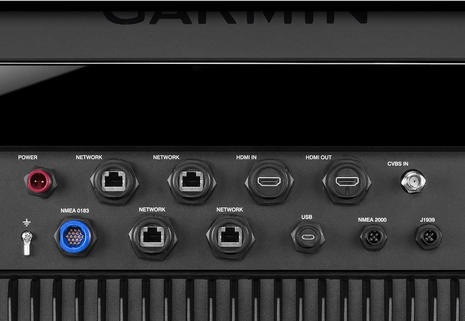
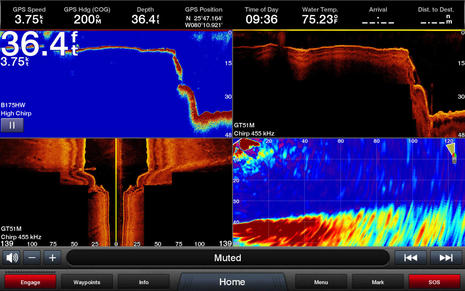
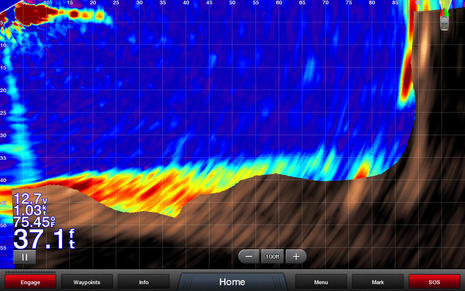
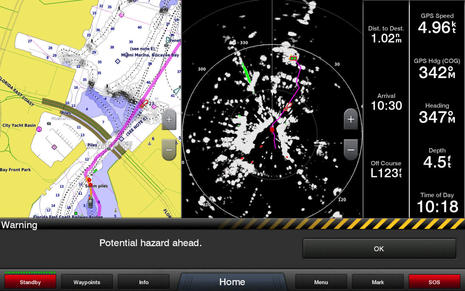
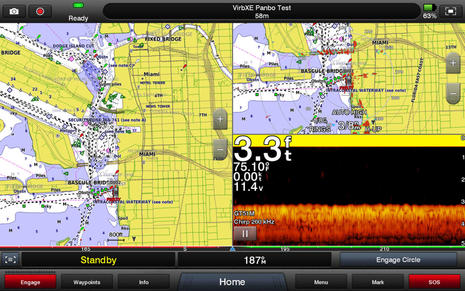

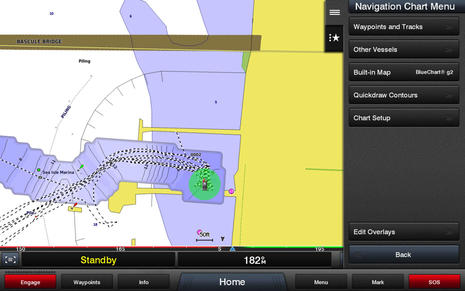
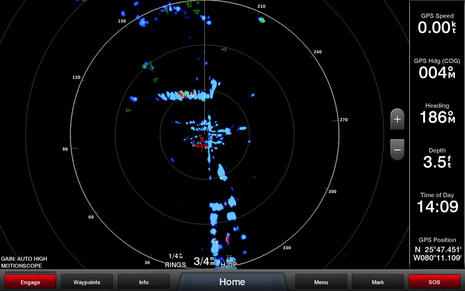
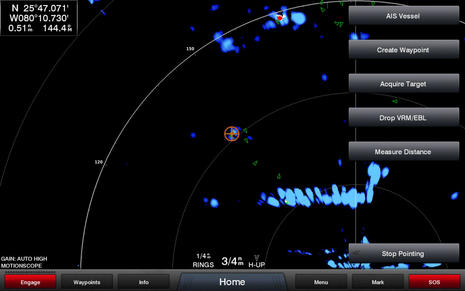
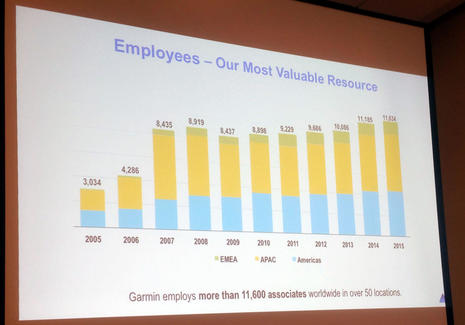
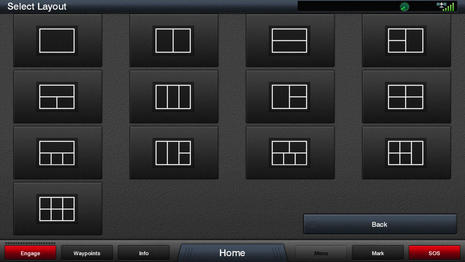
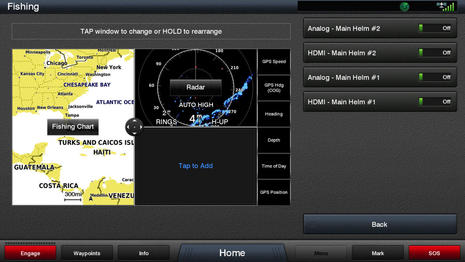


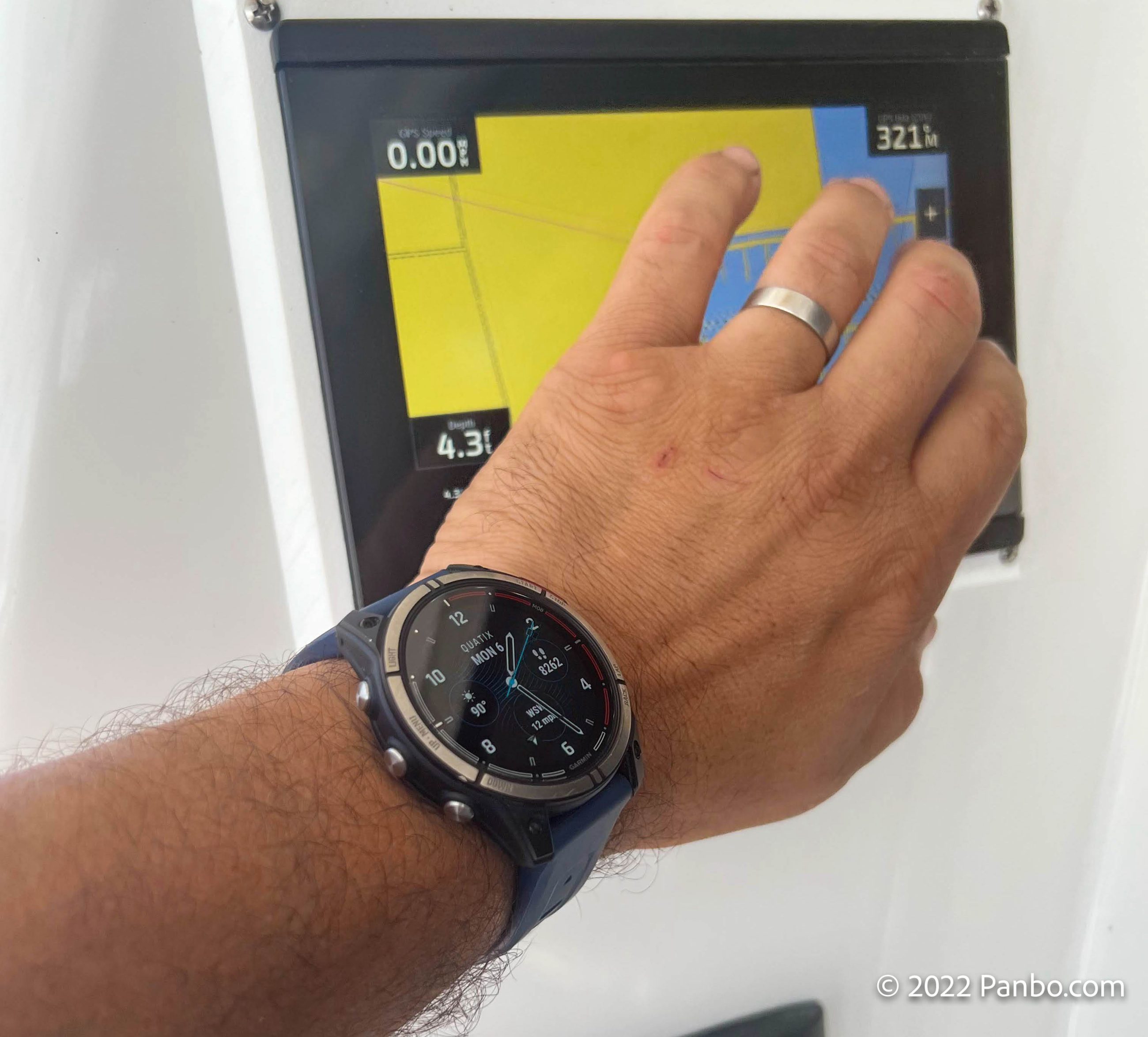
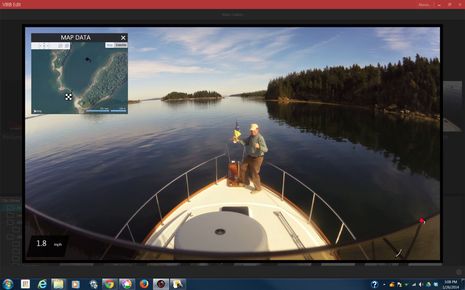
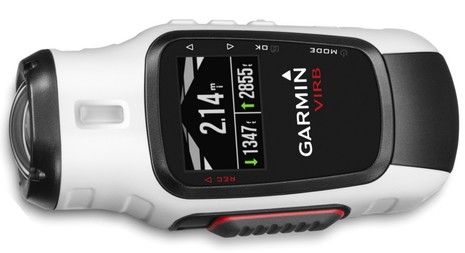







The data overlays on the video are really cool. On my wish list would be to allow the VIRB to connect via UDP / TCP to any NMEA 0183 / NMEA 2000 served data via Wifi connection. Would allow Garmin to sell more units!
The radar zoom-in with the “Stop Pointing” button can be emulated on B&G Zeus/Zeus2 only if you are on chart mode with radar overlay. The traditional radar screen does not allow the Garmin function you demonstrated.
Panoptix can detect a manatee? I’m not saying that B&G ScanForward can’t, because it has detected similar objects, but not in any sort of useful form. ScanForward will typically not show such a small and moving object… and then show it, and then not show it… Meaning, that if you already know it is there, you can spot it on ScanForward and claim you saw the manatee. But the truth is that if you did not know the manatee was there, and you only saw an intermittent shadow, you’d be more likely to attribute it to a temporary false return, which ScanForward is prone to.
Panoptix is very different sonar tech from ForwardScan. A manatee within the 30 degree wide beam of the PS21 should show as a big red target at a fair distance, like maybe 150 feet if the depth isn’t too shallow. I’m only guessing but I have seen cast lures (and fish) show well in Panoptix during various demos.
But Ben, do we (does anyone) really need a $7500 MFD? Does it add that much value over a $1000 PC?
And, as with all networked instruments, I would worry about one crash bringing down the whole system. I really like having separate information sources. Sure, there have been times (a few) when I wished I could overlay my radar display on the chart, but I can live without that. And I am not locked into any manufacturer’s charts.
$1000 computers don’t work in the sun or out in a center console open boat. The cheapest daylight visible monitors are over $2k and a laptop is $3500-4500.
Single device failure is an issue, but I think that anyone concerned about it could easily add a secondary standalone 7-9″ backup plotter.
A 7″ Furuno 1870 is an awesome plotter/GPS/sounder that can be used as a backup for $700 or less.
Given that they survived the first few weeks after installation, internal failure of recent Marine Electronics seems rarer than a blue screen of death on a PC!
Most onboard problems arise from connections outside the box, which would be equally onerous to PC’s, stereos, and gasgets plugged into cigarette lighter outlets.
April Fools no more, nearly all the key features of the PopGuard MFD from a 2011 April fools Panbo entry, such as a touch screen MFD that can work with software already installed in devices you already own, without having to actually install the software in the MFD, is achieved and surpassed by Garmin in 2016. To do this in five years is really incredible when you think back to how slowly MFD’s were evolving at that time.
https://panbo.com/archives/2011/04/ultimate_open_mfd_or_ethernet_monstrosity.html
Garmin Quickdraw Contours can use a whole range of transducers, some only show right beneath you, some (Panoptix) show a whole swatch of the bottom. According to my Garmin rep, the width of the swath that QD Contours draws on the chart matches the width of the beam on the bottom. Does it?
How good are those contours in the part away from the boat track? “You can see that Quickdraw Contours presumes water depths right over charted piers and other objects” — I take that to mean that it did NOT measure the depth to the side of the boat. Or would that need the 3D system?
Bill Bishop likes it. See his blog comments here:
http://themarineinstallersrant.blogspot.com/2016/04/quckdraw-macgraw-garmin-software.html